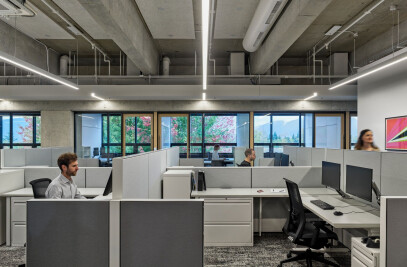Since the 1950s, Vancouver has been home to affordable modern homes with open plans and exclusive access to natural landscapes and distant views. In the current economy, detached home ownership in this Pacific Rim city is an investment vehicle for the global elite. For most, the price of home ownership has so outpaced household income that shared housing – basement suites, lane houses, attached and co-housing – is the new norm. Distant views are nearly unobtainable.
However, the basic elements of detached housing (day light, cross ventilation, front and rear garden etc.) have been achieved in this East Vancouver infill duplex. Distant views have been created internally and are borrowed, making this project unique.
As Vancouver’s climate is characterized by overcast winter and clear summer skies, the first organizing principal for both residences is to distribute a balance of south and north light access by bifurcating the permissible building mass in the north-south direction. This affords both units a front and rear garden and equal access to views of an adjacent neighbourhood park. Each unit accesses full height glazing in recessed balconies on alternating floors to minimize acoustic transfer when doors are left open in summer months. The balconies reference the porches typical to the adjacent structures.
The permissible building mass on a 33’ lot when split longitudinally results in units 12’ wide. To compensate for this modest dimension, every effort is made to elongate the project in plan and section. A specimen Japanese maple across the street is framed by full height windows. In turn the house frames a view of a specimen magnolia. The resulting view corridor is 170’ in length. In section, both unit’s internal stairs open to the full height of the prescribed peak roof, over 30’, allowing day light into the core of the plan, natural ventilation through operable skylights and the potential for third floor access. Hung from the skylights on steel rods, the stairs are a light drizzle that minimally demarcate the transition of dining and sunken living room. The main floor reads as a single room.
Materially, the monolithic shingle skin relates to the predominant palette and scale of the adjacent buildings while the lack of overhangs elevates the expression to a sculptural mass inflected by context rather than historic pastiche. Wrought steel guard rails, gates and stairs provide a counterpoint to the wood.

































